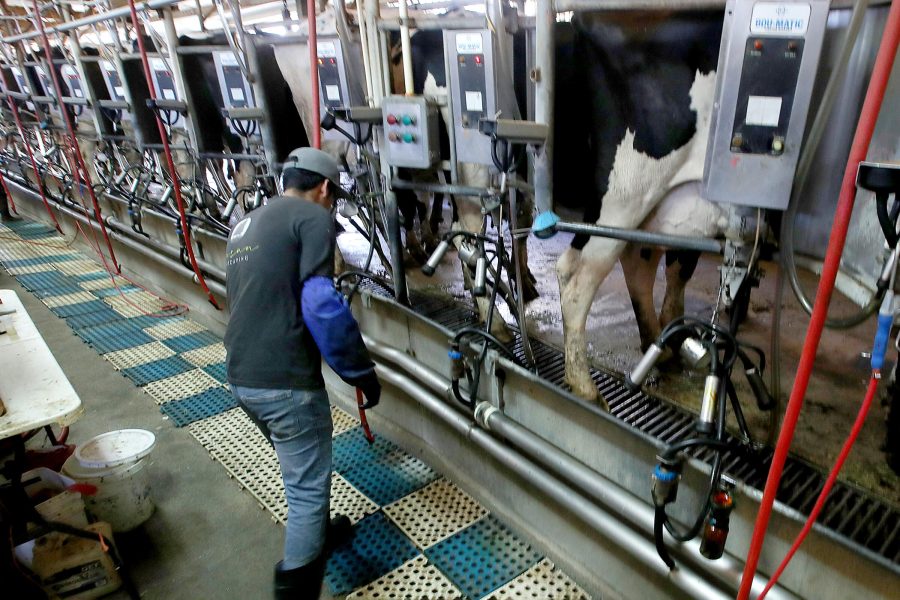A routine farm task turned deadly when a tractor tyre exploded, killing 23-year-old Joshua Hardman. The incident highlights critical safety concerns in dairy operations. How can farmers prevent such tragedies? Learn more about this heartbreaking story and its industry implications.
Summary:
Joshua Hardman, a young father, tragically died in a tire explosion at a farm in Lancashire. While helping inflate a tractor tire, the inner tube exploded, causing fatal injuries. The incident highlights the need for safety in farm work, emphasizing proper risk checks, equipment care, and staff training. The farm was fined for neglecting safety rules. This event is a strong reminder to keep workplaces safe and prevent similar tragedies.
Key Takeaways:
- The tragic death of Joshua Hardman highlights the urgent need for enhanced safety protocols in agricultural operations, particularly during routine tasks like tire inflation.
- A lack of proper planning, risk assessment, and equipment maintenance were identified as major factors contributing to the fatal incident.
- Farmers are urged to adopt comprehensive training programs, regular equipment inspections, and stringent safety procedures to prevent similar tragedies.
- W Hesketh and Sons faced legal repercussions, including a substantial fine, emphasizing the financial risks of neglecting safety standards.
- Ensuring adequate insurance coverage can provide financial protection against workplace accidents.
- Joshua Hardman’s passing serves as a reminder of the human cost of safety oversights, affecting families, team morale, and farm productivity.
- The incident calls for a proactive approach in the dairy industry to maintain a positive reputation and ensure worker safety.
- Adopting proper tire inflation techniques and safety equipment can significantly reduce the risk of accidents.

A devastating incident at W Hesketh and Sons dairy farm in Hutton, Lancashire, has resulted in the death of 23-year-old Joshua Hardman, underscoring critical safety concerns in agricultural operations.
The Incident
On May 7, 2021, Hardman was assisting farm partner Bill Hesketh in re-seating and inflating a large tractor tire. As the inner tube was being inflated, it suddenly exploded, causing a catastrophic release of compressed air that propelled the wheel rim into Hardman, inflicting severe head injuries. Despite undergoing skull and brain surgeries, Hardman’s condition deteriorated, leading to his death on June 11, 20.
Investigation Findings
The Health and Safety Executive (HSE) investigation revealed several critical safety lapses:
- Failure to properly assess and plan the tire inflation activity
- Lack of necessary risk control measures for inflating large commercial tires
- Poor maintenance of the tire, wheel rim, and inner tube, significantly increasing explosion risk
HSE inspector Anthony Banks emphasized, “This tragic incident could have easily been avoided with the right controls in place. HSE urges all employers to correctly assess risks and implement suitable controls before undertaking the inflation of large commercial tires”.
Legal Consequences
W Hesketh and Sons pleaded guilty to breaching regulation 2 of the Health and Safety At Work Act 1974. The farm partnership was fined £80,000 and ordered to pay £8,605 in court costs at Preston Magistrates’ Court on February 4, 2025.
Remembering Joshua Hardman
Hardman’s family paid tribute to the young father, describing him as “a very loving, caring, kind and gentle person” with a “heart of gold”. They added, “He was also an amazing dad, and it is heart-breaking that he will never reach his full potential in that role. His five-year-old daughter will miss out on a great deal of love and affection and the role he would have played in her life”.
Implications for the Dairy Industry
This tragic event highlights several critical issues for dairy farmers:
Workplace Safety in Dairy Operations
The incident underscores the paramount importance of workplace safety on dairy farms. Even routine maintenance activities, such as tire inflation, can pose significant risks if not properly managed.
Equipment Maintenance and Inspection
Regular equipment inspections and maintenance schedules are crucial for operational safety and efficiency. Properly maintained equipment not only ensures safety but also contributes to operational efficiency.
Risk Assessment and Management
Dairy farmers should regularly review and update their risk assessments, especially for tasks involving potentially dangerous equipment or procedures.
Training and Procedures
Comprehensive training programs and clear, written procedures for all farm tasks, including equipment maintenance, are essential. Ensuring that all staff, including seasonal or part-time workers, are adequately trained can significantly reduce the risk of accidents.
Legal and Financial Implications
The substantial fine imposed on W Hesketh and Sons serves as a reminder of the severe legal and financial consequences that can result from safety breaches. For many dairy farms, such a fine could have significant impacts on their financial stability.
Human Cost and Labor Relations
The loss of a young, skilled worker like Joshua Hardman is not just a personal tragedy but also a blow to the farm’s operations. In an industry that often struggles with labor shortages, the death of a valued employee can have long-lasting impacts on team morale and productivity.
Insurance and Liability
This case may prompt dairy farmers to review their insurance coverage, particularly their liability insurance, to ensure they are adequately protected in the event of workplace accidents.
Industry Reputation
Such incidents can negatively impact the public perception of the dairy industry. Farmers may need to be proactive in demonstrating their commitment to worker safety to maintain public trust and attract skilled workers to the sector.
Safety Recommendations for Tire Inflation
To prevent similar tragedies, farmers should follow these safety guidelines when inflating tractor tires:
- Use a tire cage or other restraining device when inflating tires.
- Stand to the side of the tire, not in front of it, during inflation.
- Use a clip-on chuck and extension hose to allow inflation from a safe distance.
- Never exceed the manufacturer’s recommended inflation pressure.
- Regularly inspect tires for wear, damage, or improper installation before inflating.
- Ensure proper training for all staff involved in tire maintenance.
The Bottom Line
This heartbreaking event is a stark reminder of the paramount importance of workplace safety in agricultural settings. It calls for a renewed focus on implementing and maintaining rigorous safety protocols to prevent similar tragedies in the future. Dairy farmers must prioritize regular equipment maintenance, comprehensive risk assessments, thorough staff training, and clear safety procedures to create safer working environments for all farm employees.
Learn more:
- Keeping Kids Safe on the Dairy Farm: Essential Tips Every Parent Should Know
- Donald Trump’s Shooting: Critical Information for Dairy Farmers
- Dairy Farm Devastated: Tornado Destroys Gajewski’s Life’s Work in Seconds
 Join the Revolution!
Join the Revolution!
Bullvine Daily is your essential e-zine for staying ahead in the dairy industry. With over 30,000 subscribers, we bring you the week’s top news, helping you manage tasks efficiently. Stay informed about milk production, tech adoption, and more, so you can concentrate on your dairy operations.







 Join the Revolution!
Join the Revolution!







